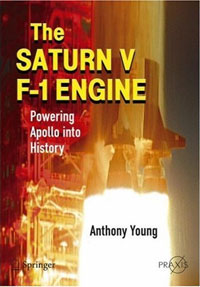|
|
Review: The Saturn V F-1 Engine
by Jeff Foust
Monday, March 16, 2009
The Saturn V F-1 Engine: Powering Apollo into History
by Anthony Young
Praxis Publishing, 2008
softcover, 304 pp., illus.
ISBN 978-0-387-09629-2
US$59.95
During a panel session of the Space Economy Symposium in downtown Washington last Friday (see “The space economy: a public-private partnership?”, The Space Review, this issue), SpaceX vice president Larry Williams was asked how the public and private sectors could work together. He responded that the most critical need for both government and business was to reduce launch costs. “If there’s one thing I think would ultimately lower the cost of access to space, it’s actually getting the civil and national security communities together to invest in the development of a new, large liquid engine, something along the lines of the F-1,” he said. “If we had the F-1 back, that would be a game-changer, in my opinion, in terms of cost of access to space.”
Ah, yes, the F-1. When development of the F-1 began a half-century ago, reducing the cost of space access wasn’t its goal: it was powering a giant launch vehicle (originally the Nova, and then the Saturn 5) that would send astronauts to the Moon. And, like the Saturn 5 itself, the F-1 engine was consigned to museums—or junked—once the Apollo program ended. Fortunately, Anthony Young provides a good overview of the history of the engine’s development in the aptly-titled The Saturn V F-1 Engine.
Young (a contributor to The Space Review) traces the roots of the F-1 back to shortly after World War 2, when North American Aviation won a contract for the development of Navaho, a supersonic cruise missile with a rocket boost stage. The Navaho was a failure, but it spurred the development of key engine technology, as well as the creation of a test site just outside Los Angeles, the Santa Susana Field Laboratory. Another little-known engine program, the E-1, also played a role in the development of the F-1: it was developed by Rocketdyne (spun out as a separate unit of North American in the mid-50s) as a backup engine for the Titan, which was being developed as a backup to the Atlas. The E-1 was proposed for the Saturn 1 but never selected, but Rocketdyne’s work on the engine gave it the experience and credibility to win the contract for the much larger F-1.
The book goes into considerable detail about the development and use of the F-1, ranging from how its various components worked together to generate 1.5 million pounds (6.7 million newtons) of thrust to how the program was managed at both Rocketdyne and NASA to how the engines were transported, tested, and used on the Saturn 5’s first stage. Young relies on a combination of primary sources, including NASA and Rocketdyne documents, as well as oral interviews with people who worked on the F-1, who provide additional insights and anecdotes that can’t be found in the original documentation.
| The author showed a pristine F-1 engine on display in Huntsville to Sonny Morea, who managed the engine program at NASA. “What a magnificent engine!” he exclaimed. |
Given the narrow focus and technical nature of its subject matter, it’s not surprising that The Saturn V F-1 Engine can be a little dry at times (it doesn’t help that there’s an extended excerpt—over 20 pages—of one NASA document that describes the “flow” of engines as they’re shipped from Rocketdyne’s California factory to the test site and then integrated onto the Saturn 5’s first stage for shipment to KSC.) Young tries to put the F-1 in context by describing the overall development of the Saturn 5 and other events associated with the program, but it’s safe to say that someone interested in this book (particularly given a hefty price tag that would deter the casual reader) is already familiar with much of the general history of the early space program.
It would have been nice to have some more of the “personal” history behind the F-1: how the engineers, managers, and others involved with it recalled their work. There is some of that in the book, like the story of seeing a convoy of trucks carrying liquid oxygen “as far as the eye could see” at Rocketdyne’s new test site at Edwards Air Force Base (when the F-1 proved too powerful for Santa Susana) to feed the voracious appetite of that engine. Or, more recently, when the author showed a pristine F-1 engine on display at the US Space and Rocket Center in Huntsville to Sonny Morea, who managed the engine program at NASA. “What a magnificent engine!” he exclaimed.
Unlike the J-2 engine, which powered the Saturn 5’s upper stages and has been resurrected for use on the Ares 1 and 5’s upper stages, the F-1 has long since been retired. (A brief section at the end of the book describes some efforts to use an upgraded variant, the F-1A, in the 1990s in concepts for Space Exploration Initiative launchers as well as a liquid flyback booster that would replace the shuttle’s SRBs; neither got beyond the drawing boards.) If the US decides, as SpaceX’s Williams proposed, to develop an F-1 class engine, is most likely will be a new design. That, however, should take nothing away from the F-1 and what it accomplished, as ably described in this book. It was indeed, as Morea said, a magnificent engine.
Jeff Foust (jeff@thespacereview.com) is the editor and publisher of The Space Review. He also operates the Spacetoday.net web site and the Space Politics and Personal Spaceflight weblogs. Views and opinions expressed in this article are those of the author alone, and do not represent the official positions of any organization or company, including the Futron Corporation, the author’s employer.
|
|
